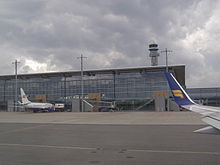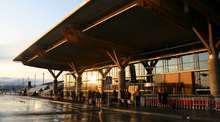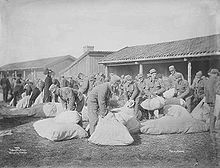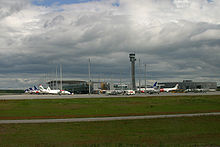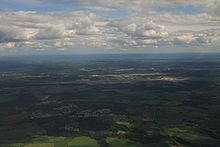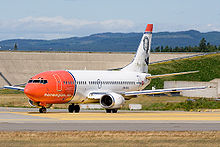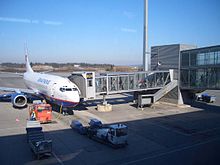- Oslo Airport, Gardermoen
-
"Gardermoen" redirects here. For other uses, see Gardermoen (disambiguation).
Oslo Airport, Gardermoen
Oslo lufthavn, Gardermoen

IATA: OSL – ICAO: ENGM Location of airport in Akershus Summary Airport type Public Operator Oslo Lufthavn AS (part of Avinor) Serves Oslo, Norway Location Gardermoen, Ullensaker Hub for - Scandinavian Airlines
- Norwegian Air Shuttle
- Widerøe
Elevation AMSL 681 ft / 208 m Coordinates 60°12′10″N 011°05′02″E / 60.20278°N 11.08389°ECoordinates: 60°12′10″N 011°05′02″E / 60.20278°N 11.08389°E Website Runways Direction Length Surface m ft 01L/19R 3,600 11,811 Asphalt/concrete 01R/19L 2,950 9,678 Asphalt/concrete Statistics (2010) Passengers 19,091,036 Aircraft movements 219,352 Cargo (tonnes) 71,796 Source: Norwegian AIP at Eurocontrol[1] Oslo Airport, Gardermoen (IATA: OSL, ICAO: ENGM) (Norwegian: Oslo lufthavn, Gardermoen) is the principal airport serving Oslo, Norway. It acts as the main domestic hub and international airport for Norway, and the second-busiest airport in the Nordic countries. A hub for Scandinavian Airlines and Norwegian Air Shuttle, and a focus city for Widerøe, it is connected to 26 domestic, about 100 European and 7 intercontinental destinations. More than 19 million passengers traveled through Oslo Airport in 2010, of which 8.6 million were domestic—making Gardermoen the sixth-busiest domestic airport in Europe.
The airport is located at Gardermoen in Ullensaker, 19 nautical miles (35 km; 22 mi) northeast of Oslo. The airport has two parallel roughly north–south runways 3,600 metres (11,800 ft) and 2,950 metres (9,680 ft) long, 71 aircraft stands, of which 34 have jet bridges. The airport is connected to the city center by the high-speed Gardermoen Line served by mainline trains and Flytoget. The civilian facilities are owned by Oslo Lufthavn AS, a subsidiary of the state-owned Avinor. Also at the premises is Gardermoen Air Station, operated by the Royal Norwegian Air Force. Oslo is also served by the low-cost Sandefjord Airport, Torp and Moss Airport, Rygge.
The area was taken into use by the Norwegian Army in 1740, with the first military airport facilities being built during the 1940s. Gardermoen remained a secondary reserve and charter airport to Oslo Airport, Fornebu until 8 October 1998, when the latter closed and an all-new Gardermoen opened, costing NOK 11.4 billion. An expansion with a third pier is scheduled to open after 2012.
Contents
Facilities
The airport covers an area of 13 square kilometres (5.0 sq mi).[2] It is built based on the Atlanta-model, with two parallel runways and a single terminal with two piers on a single line.[3] Non-commercial and practice general aviation is not operated at Gardermoen, and is mainly done from Kjeller Airport, Rakkestad Airport and Tønsberg Airport, Jarlsberg.[4] Gardermoen is located 19 nautical miles (35 km; 22 mi) north-northeast of Oslo city center.[1]
Terminal
The passenger terminal covers 148,000 square metres (1,590,000 sq ft) and is 819 metres (2,687 ft) long.[2][5] It has place for 52 aircraft, of which 34 are connected with bridges and eighteen are remotely parked.[2] Domestic gates are located in the west wing, while international gates are in the east wing, with non-Schengen gates at the east end. Three of the gates are "flexigates" for both domestic and international Schengen flights, another four gates near the east end are flexigates for both Schengen and non-Schengen flights.[6] EU controllers have been somewhat sceptical of the Schengen/non-Schengen flexigates, and there were a few incidents where the wrong doors were opened so that passengers who should have gone through the border control did not.[7] Capacity is 17 million,[2] although in 2008, 19.3 million passengers used the airport. The airport is "silent", so announcements for flights are only done in the immediate vicinity of the gate. There is a playground in both the domestic and international sections, and a quiet room in the domestic section. There are stationed medical personnel at the airport.[8]
About half the airport operator's income is from retail revenue. There are twenty eating places, of which seven are operated by Reitangruppen and thirteen by Select Service Partner. In addition there are stores and other services including banks and post. 7,200 square metres (78,000 sq ft) is used for restaurants, stores and non-aviation services.[9] The duty-free shop is 1,530 square metres (16,500 sq ft) and the largest in Europe. The shop is located in front of the international concourse, taking up a large part of the terminal's width.[10] The airport has attempted to funnel all passengers through the duty free.[11] Signs that were to hinder passengers from walking outside the duty-free were in 2008 removed after criticism.[12][13] Also arriving passengers have access to duty free in the baggage claim area.
The airport operates its own VIP lounge for the Norwegian Royal Family, for members of the norwegian government and members of foreign royal familys and governments. On the west side of the airport area is the GA-Terminal that services cargo airlines, executive jets and ambulance aircraft.[14] The airport is heated using district heating with a geothermal source. The airport uses 32.6 GWh/year for heating and 5.6 GWh/year for cooling. In addition, the airport uses 110 GWh/year of electricity.[15]
Art and architecture
Architects were Aviaplan, a joint venture between the agencies Narud Stokke Wiig, Niels Torp, Skaarup & Jespersen and Hjellnes Cowi.[3] Main architect was Gudmund Stokke. The terminal building has a light, floating roof that gives a simple construction. First the walls were erected, and a roof put on top. Afterwards, internal facilities could be added. The roof is held up with wooden reefers. The main construction materials are wood, metal and glass. The airlines were required to follow the same design rules for their buildings as the terminal.[16]
The main art on the land side of the airport is Alexis, consisting of six steel sculptures in stainless steel created by Per Inge Bjørlo. On the air side, Carin Wessel used 30,000 metres (98,000 ft) of thread to make the impression of clouds and webs, named Ad Astra. Anna Karin Rynander and Per-Olof Sandberg cooperated in making two installations: The Marathon Dancers, located in the baggage claim area, is a set of two electronic boards that show a dancing person. Sound Refreshment Station, of which six are located in the departure areas, are sound "showers" that make refreshing sounds when a person is immediately under them. Sidsel Westbø has etched the glass walls. In the check-in area, there are small boxes under the floor with glass ceilings that contain curiosities. As well as the custom-made art, several existing sculptures and paintings have been bought.[17] At the National Road 35 and European Route E6 junction, Vebjørn Sand has built a 14-metre (46 ft) statue named the Kepler Star. It consists of two internally-illuminated Kepler–Poinsot polyhedrons, appearing like a giant star in the sky after dark.
Runways and air control
The airport has two parallel runways, aligned 01/19. The west runway is 3,600 metres (11,800 ft) long, while the east runway is 2,950 metres (9,680 ft) long. Both have taxiways, allowing 80 air movements per hour.[2] The runways are equipped with CAT IIIA instrument landing system[18] and the airport is supervised by a 90-metre (300 ft) tall control tower.[2] Once aircraft are 15 kilometres (9 mi) from the airport, responsibility is taken over by Oslo Air Traffic Control Center, who supervises the airspace with Haukåsen Radar. There are two ground radars at the airport, located on the far sides of each of the runways. Both at the gates and along the taxiways, there is an automatic system of lights that guide the aircraft. On the tarmac, these are steered by the radar, while they are controlled by motion sensors at the gate.[19]
There are four deicing stations. Both fire stations each have three fire cars, and is part of the municipal fire department. Meteorological services are operated by the Norwegian Meteorological Institute, which has 12 weather stations and 16 employees at the airport. This includes Norway's first aeronautic information service and a self-briefing room, in addition to briefings from professionals.[20] Restrictions on air movements apply overnight from 23:00 to 06:00, although permitted if landing from and taking off to the north.[21]
Air station
The Royal Norwegian Air Force has an air base at Gardermoen, located north of the passenger terminal. The base dates from 1994 and houses the 335-Squadron that operates four Lockheed C-130 Hercules transport planes. The airbase also handles nearly all millitary freight going abroad. The Air Force has a compact 41,000 square metres (440,000 sq ft) building space, with a maximum walking distance of 400 metres (1,300 ft). The station is built so that it can quickly be expanded if necessary, without having to claim areas used by the civilian section. The military also use the civilian terminals for their passenger transport needs, and send 200,000 people with chartered and scheduled flights from the main terminal each year.[22] The airforce station at Gardermoen serves as the main entering point for VIP's and officials going to Norway.
Organisation
The airport is owned by Oslo Lufthavn AS, a limited company wholly owned by Avinor, a state-owned company responsible for operating 46 Norwegian airports. In 2008, Oslo Lufthavn had a revenue of NOK 3,585 million, giving an income of NOK 1,125 million. The profit from the airport is largely paid to Avinor, who uses it to cross-subsidise operating deficits from smaller primary and regional airport throughout the country. In 2008, Oslo Lufthavn had 435 employees.[23]
The company has a subsidiary, Oslo Lufthavn Eiendom AS, which is responsible for developing commercial real estate around the airport. It owns one airport hotel run by the Radisson Blu chain, the office building and conference center Flyporten, which along with the hotel features 60 conference rooms, and the employee parking lot. The company has started construction of a second hotel, which is scheduled for completion in 2010. The subsidiary had a revenue of NOK 126,9 million and a profit of 54,8 million in 2008. All telecommunications and information technology services at the airport are provided by Oslo Lufthavn Tele og Data AS, a joint venture between Oslo Lufthavn and Telenor.[23][23] Aircraft ground handling is provided by four companies: SAS Ground Services,[24] Røros Flyservice,[25] Menzies Aviation[26] and Spirit Air Cargo Handling.[27]
Airlines and destinations
Gardermoen serves 107 airports, of which 24 are domestic.[28] The two main domestic airlines to use Gardermoen are Scandinavian Airlines System (SAS) and Norwegian Air Shuttle. Gardermoen functions, along with the other two Scandinavian capital airports, as a hubs for SAS, while it is the main hub for Norwegian. Domestically, SAS offers flights to fourteen primary airports, while Norwegian Air Shuttle offers flights to thirteen.[29] In Southern Norway, the Ministry of Transport and Communications subsidizes the services to eight regional airports based on three-year public service obligations. From 2009 to 2012, these are operated by Danish Air Transport and its subsidiary Danu Oro Transportas, and by Widerøe.
In addition to the range of international services provided by SAS and Norwegian, a span of foreign airlines provide services. Intercontinental flights are offered by Continental Airlines and SAS to Newark, by Norwegian to Dubai, by Thai Airways International to Bangkok, by Pakistan International Airlines to Islamabad and Lahore and by Qatar Airways to Doha.
A wide range of direct charter flights are offered from Oslo Airport, mostly to leisure destinations on the Mediterranean Sea, but also to destinations as far away as Cancun in Mexico, Varadero in Cuba, Phuket and Krabi in Thailand. Large operators based at Gardermoen include Novair,[30] TUIfly Nordic[31] and Thomas Cook Airlines Scandinavia, although many other also fly.
Airlines Destinations Aeroflot Moscow-Sheremetyevo airBaltic Riga Air Berlin Berlin-Tegel Air France Paris-Charles de Gaulle Air Méditerranée Seasonal: Bordeaux, Lyon, Marseille, Nantes, Paris-Charles de Gaulle, Strasbourg, Toulouse Air Norway operated by North Flying Aalborg, Brekstad Austrian Airlines Vienna Austrian Airlines operated by Tyrolean Airways Vienna Blue1 Helsinki British Airways London-Heathrow British Airways operated by Sun Air Aarhus Brussels Airlines Brussels Cimber Sterling Aalborg, Billund Continental Airlines Newark Czech Airlines Prague Danish Air Transport Florø, Stord Direktflyg Karlstad Danu Oro Transportas Fagernes, Røros Estonian Air Tallinn Finnair Helsinki Iberworld Tenerife-South Icelandair Reykjavík-Keflavík Iceland Express Seasonal: Reykjavík-Keflavík KLM Amsterdam Lufthansa Frankfurt, Munich Lufthansa Regional operated by Lufthansa CityLine Düsseldorf, Hamburg, Munich Malmo Aviation Pula, Split Norwegian Air Shuttle Agadir, Ålesund, Alicante, Alta, Amsterdam, Andøya (Andenes) [begins 2 June 2012], Antalya, Arrecife, Athens, Barcelona, Bardufoss, Belgrade, Bergen, Berlin-Schönefeld, Billund, Bodø, Bratislava [begins 28 March 2012], Budapest, Burgas, Chania, Copenhagen, Corfu, Dubai, Dublin, Dubrovnik, Düsseldorf, Edinburgh, Faro, Funchal, Gdańsk, Geneva, Hamburg, Harstad/Narvik, Haugesund, Helsinki, Heraklion, Ibiza, Istanbul-Sabiha Gökçen, Kiev-Boryspil [begins 1 June 2012], Krakow, Kristiansand, Lakselv, Larnaca, Las Palmas de Gran Canaria, London-Gatwick, Málaga, Manchester, Marrakech, Milan-Malpensa, Molde, Murcia, Munich, Nice, Olbia, Palanga, Palma de Mallorca, Paris-Orly, Poznań, Pisa, Prague, Pristina, Pula, Reykjavik-Keflavik [begins 1 June 2012], Riga, Rijeka, Rome-Fiumicino, Saint Petersburg, Salzburg, Sarajevo, Split, Stavanger, Stockholm-Arlanda, Szczecin, Tallinn, Tenerife-South, Tromsø, Trondheim, Varna, Venice-Marco Polo, Vienna, Vilnius, Warsaw
Seasonal: Ajaccio [begins 2 June 2012], Bordeaux, Grenoble, Santorini, Skiathos [begins June 2012].Novair Burgas, Fuerteventura, Kefalonia, Las Palmas de Gran Canaria Pakistan International Airlines Islamabad, Lahore Qatar Airways Doha Scandinavian Airlines Ålesund, Alicante, Alta, Amsterdam, Barcelona, Bergen, Bodø, Brussels, Copenhagen, Dublin, Düsseldorf, Frankfurt, Gdansk, Geneva [begins 21 January], Harstad/Narvik, Haugesund, Kirkenes, Kristiansand, Kristiansund, Las Palmas de Gran Canaria, London-Heathrow, Longyearbyen, Madrid, Málaga, Manchester, Milan-Malpensa, Molde, Moscow-Sheremetyevo, Munich, Newark, Nice, Palanga, Palma de Mallorca, Paris-Charles de Gaulle, Reykjavík-Keflavík, Rome-Fiumicino, Split, Stavanger, Stockholm-Arlanda, Tromsø, Trondheim, Zürich
Seasonal; Alanya-Gazipaşa [begins 3 June 2012], Antalya [begins 1 July 2012], Bardufoss, Faro [begins 26 June 2012]SATA International Ponta Delgada SunExpress Antalya, Izmir Swiss International Air Lines Zürich TAP Portugal Lisbon Thai Airways International Bangkok-Suvarnabhumi Turkish Airlines Istanbul-Atatürk Widerøe Bergen, Brønnøysund, Førde, Gothenburg-Landvetter, Ørsta/Volda, Sandane, Sogndal
Seasonal: Rønne, Sumburgh, VisbyTraffic
Oslo Airport has a catchment area of 2.5 million people, including most of Eastern Norway and 0.3 million people in Sweden.[32] In 2009, Oslo Airport served 18,087,722 passengers, 77,761 tonnes (76,533 long tons; 85,717 short tons) of cargo and 211,048 aircraft movements, down from 2008.[33] Within the European Economic Area (EEA) in 2008, Oslo Airport ranked as the seventeenth-busiest overall, and the sixth-busiest in domestic traffic. It is the second-busiest airport in the Nordic countries, after Copenhagen Airport. The busiest route is to Trondheim, which with 1.6 million passengers was the tenth-busiest route within the EEA.[34] Along with the domestic routes to Bergen and Stavanger, and the international routes to Copenhagen and Stockholm, Oslo Airport served five of the twenty-five busiest routes in the EEA in 2007, all with more than one million passengers.[34]
Busiest international routes (2010)[34] Rank Airport Passengers Carriers 1  Copenhagen, Denmark
Copenhagen, Denmark1 132 000 Norwegian Air Shuttle, Scandinavian Airlines 2  Stockholm, Sweden
Stockholm, Sweden1 003 000 Norwegian Air Shuttle, Scandinavian Airlines 3  London (Heathrow and Gatwick), United Kingdom
London (Heathrow and Gatwick), United Kingdom838 000 British Airways, Norwegian Air Shuttle, Scandinavian Airlines 4  Amsterdam, Netherlands
Amsterdam, Netherlands542 000 Blue1,KLM Royal Dutch Airlines, Norwegian Air Shuttle, Scandinavian Airlines 5  Frankfurt, Germany
Frankfurt, Germany432 000 Lufthansa, Scandinavian Airlines 6  Paris (Charles de Gaulle and Orly), France
Paris (Charles de Gaulle and Orly), France385 000 Air France, Norwegian Air Shuttle, Scandinavian Airlines 7  Helsinki, Finland
Helsinki, Finland282 000 Finnair, Norwegian AIr Shuttle, Scandinavian Airlines 8  Las Palmas, Spain
Las Palmas, Spain250 000 Novair, Norwegian Air Shuttle, Scandinavian Airlines 9  Munich Germany
Munich Germany246 000 Lufthansa, Norwegian Air Shuttle, Scandinavian Airlines 10  Antalya, Turkey
Antalya, Turkey182 000 Norwegian Air Shuttle, Scandinavian Airlines, Sun Express 11  Riga, Latvia
Riga, Latvia179 000 airBaltic, Norwegian Air Shuttle 12  Zurich, Switzerland
Zurich, Switzerland174 000 Scandinavian Airlines, SWISS 13  Reykjavik, Iceland
Reykjavik, Iceland169 000 Icelandair, Iceland Express, Scandinavian Airlines 14  Brussels, Belgium
Brussels, Belgium168 000 Brussels Airlines, Scandinavian Airlines 15  Berlin (Schönfeld and Tegel), Germany
Berlin (Schönfeld and Tegel), Germany161 000 Air Berlin, Norwegian Air Shuttle Busiest domestic routes (2010)[34] Rank Airport Passengers Carriers 1  Trondheim
Trondheim1 588 000 Norwegian Air Shuttle, Scandinavian Airlines 2  Bergen
Bergen1 512 000 Norwegian Air Shuttle, Scandinavian Airlines 3  Stavanger
Stavanger1 275 000 Norwegian Air Shuttle, Scandinavian Airlines 4  Tromsø
Tromsø789 000 Norwegian Air Shuttle, Scandinavian Airlines 5  Bodø
Bodø641 000 Norwegian Air Shuttle, Scandinavian Airlines 6  Ålesund
Ålesund519 000 Norwegian Air Shuttle, Scandinavian Airlines 7  Harstad/Narvik
Harstad/Narvik472 000 Norwegian Air Shuttle, Scandinavian Airlines 8  Kristiansand S.
Kristiansand S.444 000 Norwegian Air Shuttle, Scandinavian Airlines 9  Haugesund
Haugesund389 000 Norwegian Air Shuttle, Scandinavian Airlines 10  Molde
Molde299 000 Norwegian Air Shuttle, Scandinavian Airlines 11  Alta
Alta190 000 Norwegian Air Shuttle, Scandinavian Airlines 12  Bardufoss
Bardufoss189 000 Norwegian Air Shuttle, Scandinavian Airlines 13  Kirkenes
Kirkenes174 000 Norwegian Air Shuttle, Scandinavian Airlines 14  Kristiansund N.
Kristiansund N.170 000 Scandinavian Airlines Ground transport
Situated about 47 kilometres (29 mi) from the city center,[35] Oslo Airport offers extended public transporting services. The airport has the world's highest degree of public transport, with a share of 60 %.[36]
The 64 kilometres (40 mi) Gardermoen Line opened the same day as the airport, and runs in a tunnel below the airport facilities, where Oslo Airport Station is located below the terminal. The Flytoget airport express train operates to Oslo Central Station six times per hour in nineteen minutes, with three services continuing onwards via five intermediate stations to Drammen Station.[37] The Airport Express Train has a 34 % ground transport share.[38]
The Norwegian State Railways (NSB) also operates from the airport, both a commuter train service to Eidsvoll and Kongsberg, and a regional service north to Oppland and Hedmark, and south to Vestfold. Both offer services to Oslo, and the latter allows direct service to Sandefjord Airport, Torp. Five daily express trains to Trondheim stop at the airport, including one night train.[39]
The Oslo Airport Express Coach serves the airport, from Oslo, Fredrikstad, Ski and Gjøvik.[40] In addition, most express buses from other parts of Norway stop at the airport. The local transport authority, Ruter, operates a number of services to Gardermoen from nearby places.
The airport is located on Norwegian National Road 35, which connects as a four-lane motorway to the European Route E6 about 6 kilometres (3.7 mi) to the east. The E6 runs south with four lanes to Oslo, and northwards with two or four lanes towards Oppland, Hedmark and Central Norway. National Road 35 connects with two lanes westward as a toll road towards Southern Oppland.[41] There are 11,400 parking spaces at the airport,[42] as well as taxi stands and rental car facilities.
History
Military and secondary
The Norwegian–Danish army started using Gardermoen as a camp in 1740, although it was called Fredericksfeldt until 1788. It was first used by the cavalry, then by the dragoons and in 1789 by the riding marines. The base was also taken into use by the infantry from 1834 and by the artillery from 1860. Tents were solely used until 1860, when the first barracks and stalls were taken into use. Isolated buildings were built around 1900, allowing the camp to be used year-round. By 1925, the base had eleven camps and groups of buildings.[43] The first flight at Gardermoen happened in 1912, and Gardermoen became a station for military flights. However, only fields and dirt surfaces were used.[44]
During the occupation of Norway by Nazi Germany, the Luftwaffe took over Gardermoen, and built the first proper airport facilities with hangars and two crossing runways, both 2,000 metres (6,600 ft) long. After World War II, the airport was taken over by the Norwegian Air Force and made the main air station. Three fighter and one transport squadron were stationed at the Gardermoen.[43]
In 1946, Braathens SAFE established their technical base at the airport, but left two years later. Gardermoen also became the reserve airport for Oslo Airport, Fornebu, when the latter was closed due to fog. From 1946 to 1952, when a longer runway was built at Fornebu, all intercontinental traffic was moved to Gardermoen. Gardermoen grew up as a training field for the commercial airlines and as local airport for general aviation. Some commercial traffic returned again in 1960, when SAS received its first Sud Aviation Caravelle jet aircraft, that could not use the runway at Fornebu until it was extended again in 1962. SAS introduced a direct flight to New York in 1962, but it was quickly terminated.[45]
In 1972, capacity restraints forced the authorities to move all charter traffic from Fornebu to Gardermoen. However, SAS and Braathens SAFE were allowed to keep their charter services from Fornebu, so they would not have to operate from two bases.[46] A former hangar was converted to a terminal building and in 1974 passenger numbers were at 269,000 per year. In 1978, SAS started a weekly flight to New York. In 1983, further restrictions were enforced, and also SAS and Braathens SAFE had to move their charter operations to Gardermoen, increasing passenger numbers that year to 750,000. Several expansions of runway were made after the war, and by the 1985-extension the north-south runway was 3,050 metres (10,010 ft).[47]
Localization debate
Main article: Oslo Airport localization controversyThe first airports to serve Oslo was Kjeller Airport that opened in 1912 and Gressholmen Airport that served seaplanes after its opening in 1926.[48] Norway's first airline, Det Norske Luftfartrederi, was founded in 1918 and the first scheduled fights were operated by Deutsche Luft Hansa to Germany with the opening of Gressholmen.[49] In 1939, a new combined air and land airport opened at Fornebu.[50] It was gradually expanded, with a runway capable of jet aircraft opening in 1962 and a new terminal building in 1964. But due to its location on a peninsula about 8 kilometres (5.0 mi) from the city center and close to large residential areas, it would not be possible to expand the airport sufficiently to meet all foreseeable demand in the future.[51] Following the 1972 decision to move charter traffic to Gardermoen, politicians were forced to choose between a "divided solution" that planners stated would eventually force all international traffic to move to Gardermoen, or to build a new airport.[52]
Gardermoen had been proposed as a main airport for Oslo and Eastern Norway as early as 1946, both by the local newspaper Romerikes Blad and by Ludvig G. Braathen, who had just founded Braathens SAFE.[53] In 1970, a government report recommended that a new main airport be built at Hobøl, but stated that the time was still not right. The areas were therefore reserved.[54] During the 1970s, it became a political priority by the socialist and center parties to reduce state investments in Eastern Norway to stimulate growth in rural areas.[55] In 1983, parliament voted to keep the divided solution permanently, and expand Fornebu with a larger terminal.[56]
By 1985, traffic had increased so much that it became clear that by 1988 all international traffic would have to move to Gardermoen. The areas at Hobøl had been freed up, and a government report was launched recommending that a new airport be built at Gardermoen, although an airport at Hurum had also been surveyed. However, the report did not look into the need of the Air Force that was stationed at Gardermoen, and was therefore rejected by the parliament the following year. In 1988, a majority of the government chose Hurum as their preferred location, and Minister of Transport Kjell Borgen withdrew from his position. In 1989, new weather surveys from Hurum showed unfavorable conditions. There were large protests from meteorologists and pilots who stated that the surveys were manipulated. Two government committees were appointed, and both concluded that there were no irregularities in the surveys.[57]
Since Hurum could no longer be used, the government again recommended Gardermoen as the location. The Conservative Party instead wanted to build at Hobøl, but chose to support the Labour Party government's proposal to get a new airport as quickly as possible. Parliament passed legislation to build the new main airport at Gardermoen on 8 August 1992. At the same time, it was decided that a high-speed railway was to be built to Gardermoen, so the airport would have a 50% public transport market share.[58]
The choice of Gardermoen has spurred controversy, also after the matter was settled in parliament. In 1994, Engineer Jan Fredrik Wiborg, who claimed that falsified weather reports had been made, died after falling from a hotel window in Copenhagen. Circumstances about his death were never fully cleared up and documents about the weather case disappeared.[59][60] The Standing Committee on Scrutiny and Constitutional Affairs held a hearing about the planning process trying to identify any irregularities. An official report was released in 2001.[61][62]
Construction
To minimize the effect of using state grants to invest in Eastern Norway, parliament decided that the construction and operation of the airport was to be done by an independent limited company that would be wholly owned by the Civil Airport Administration (today Avinor). This model was chosen to avoid having to deal with public trade unions and to ensure that the construction was not subject to annual grants.[63] This company was founded in 1992 as Oslo Hovedflyplass AS, but changed its name in 1996 to Oslo Lufthavn. From 1 January 1997, it also took over the operation of Oslo Airport, Fornebu. The company was established with NOK 200 million in share capital. The remaining assets were NOK 2 billion from the sale of Fornebu and NOK 900 million in responsible debt. The remaining funding would come from debt from the state. Total investments for the airport, railways and roads were NOK 22 billion, of which Oslo Lufthavn would have a debt of NOK 11 billion after completion.[63]
At Gardermoen there was both an air station and about 270 house owners that had their real estate expropriated following parliament's decision. NOK 1.7 billion were used to purchase land, including the Air Force. It was the state that expropriated and bought all the land and remained land owner, while Oslo Lufthavn leases the ground from the state.[64] The first two years were used to demolish and rebuild the air station. This reduced the building area from 120,000 to 41,000 square metres (1,300,000 to 440,000 sq ft), but gave a more functional design.[65]
Construction of the new main airport started on 13 August 1994.[66] The western runway was already in place, and had been renovated by the Air Force in 1989. A new, eastern runway needed to be built. A hill at the airport was blown away, and the masses used to fill in where needed. The construction of the airport and railway required 13,000 man-years. 220 subcontractors were used, and working accidents were at a third of the national average, without any fatalities.[67] The last flights to Fornebu took place on 7 October 1998. That night, 300 people and 500 truckloads transported equipment from Fornebu to Gardermoen. Gardermoen opened on 8 October 1998.[2]
The airlines needed to build their own facilities at Gardermoen. SAS built a complex with 55,000 square metres (590,000 sq ft), including a technical base, cabin storage, garages and cargo terminals, for NOK 1,398 billion. This included a technical base for their fleet of Douglas DC-9 and McDonnell Douglas MD-80-aircraft for NOK 750 million. The cargo handling facility is 21,000 square metres (230,000 sq ft) and was built in cooperation with Posten Norge. SAS also built two lounges in the passenger terminal. Since Braathens had its technical base at Stavanger Airport, Sola, it used NOK 200 million to built facilities. This included a 9,000 square metres (97,000 sq ft) hangar for six aircraft for NOK 100 million.[68]
Parliament decided to build a high-speed airport rail link from Oslo to Gardermoen. The 64-kilometre (40 mi) Gardermoen Line connects Oslo Central Station (Oslo )to Gardermoen and onwards to Eidsvoll. This line was constructed for 210 kilometres per hour (130 mph) and allows the Flytoget train to operate from Oslo Central station to Gardermoen in nineteen minutes. Just like the airport, the railway was to be financed by the users. The Norwegian State Railways (NSB) established a subsidiary, NSB Gardermobanen, which would build and own the railway line, as well as operate the airport trains. The company would borrow money from the state, and repay with the profits from operation. During construction of the Romerike Tunnel, a leak was made that started draining the water from the lakes above.[69] The time and cost to repair the leaks meant that the whole railway line budget become exceeded, and the tunnel would not be taken into use until 1 August 1999. Since the rest of the railway was finished, two trains (instead of the intended six), operated using more time from the opening of the new airport.
The main road corridor northwards from Oslo to Gardermoen is European Route E6. The E6 was upgraded to six lanes north to Hvam, and to four lanes north to Gardermoen. The E6 runs about 6 kilometres (3.7 mi) east of the airport, so 6 kilometres (3.7 mi) of Norwegian National Road 35 was upgraded to four-lane motorway to connect the E6 to the airport. This connection cost NOK 1 billion. After the opening of the airport, National Road 35 was upgraded west of the airport as a two-lane toll road. Also Norwegian National Road 120 and Norwegian National Road 174 were upgraded.[41]
Opening and growth
The first new airline to start scheduled flights was Color Air that started on ... The low-cost airline took advantage of the increased capacity that Gardermoen created to start competing with SAS and Braathens on the routes to Bergen, Trondheim and Ålesund. This lasted until October 1999, when Color Air filed for bankruptcy. During this time, all three airlines lost large amounts of money, mainly due to low cabin loads. To win the business market, all three wanted to have the most possible departures per day to other cities.
Gardermoen has had considerable problems with fog and freezing rain, and has several times had a complete close-down. This was also a problem at Fornebu, and reported to be at Hurum as well. On average there is super cooled rain three times per month during the winter.[61] The use of deicing fluids is restricted since the area underneath the airport contains the Tandrum Delta, on of the country's largest uncontained quaternary aquifers (underground water systems).[70] On 14 December 1998, a combination of freezing fog and supercooled rain caused glaze at Gardermoen. At least twenty aircraft engines were damaged by ice during take-off, and five aircraft needed to make precautionary landingss with only one working engine.[61] On 18 January 2006, an Infratek deicing system was set up, that uses infrared heat in large hangar tents. It was hoped that it could reduce chemical deicers by 90%, but the technique has proved unsuccessful.[71]
In 1999, Northwest Airlines briefly operated a flight between Oslo and Minneapolis, United States, for several month before the flight was canceled due to poor load factors.[72][73] In October 2001, the only remaining intercontinental flight, to New York-Newark, with SAS' Boeing 767-300 aircraft was discontinued. In 2004, Continental Airlines resumed service on this route. There is also a regular connection to Islamabad, Lahore, Dubai, Philadelphia, Marrakech and Bangkok.
Future plans
Due to a rather rapid increase in passenger numbers recently, the airport has already exceeded its original capacity limit of 17 million passengers and is soon to reach the critical limit of 20 million. As a result, the Norwegian Air Transport Authority Avinor approved plans on January 19th 2011 for the expansion of OSL with Terminal 2. Set to be finished in 2017, the expansion includes a new pier located directly after security checkpoint with 11 new air bridges, 6 remote stands, a new arrivals- and departure-hall and a new baggage handling system. A total of 117 000 m2 will be added to today's 148 000 m2. Upon completion of this first expansion phase, OSL is set to handle approximately 28 million passengers a year, making it Scandinavia's largest airport by passenger numbers. A second phase will be added later on to bring the total capacity to 35 million passengers.
There are plans for increasing the terminal area by adding a new terminal 2 (T2) situated 500 meters north of the present terminal: this is connected by an underground passage and may be completed in 2012 at the earliest. T2 will hold up to eight planes. This idea was predicted even before the completion of the airport, it was therefore included in the development plans of the airport as a whole. Also starting in 2009 with the same expected completion date as T2 is a new pier for the current terminal that will hold an additional ten aircraft. This expansion will also include an expansion of the check-in areas.[74]
The Government has discussed the opportunity of a third runway in the future, but it is not planned to be completed until 2030. Estimates by Avinor show that the runway will be necessary by 2030, but critics have pointed out that much larger airports, such as London Heathrow Airport, only have two runways. Former Minister of Transport, Liv Signe Navarsete (Center), has stated that spreading the traffic between the three airports will result in inconvenience for air passengers and a massive need for inter-airport ground transportation, but has announced that she is opposed to a third runway.[75]
The name
Gardermoen is a compound of the farm name Garder and the finite form of mo m 'moor; drill ground' (thus 'the moor belonging to the farm Garder'). The farm is first mentioned in 1328 (Garðar), and the name is the plural of Norse garðr m 'fence'. The meaning is probably 'enclosure; fenced fields'.
References
Notes
- ^ a b EAD Basic
- ^ a b c d e f g Bredal, 1998: 42
- ^ a b Bredal, 1998:45
- ^ Bredal, 1998: 194
- ^ Bredal, 1998: 188
- ^ Map of OSL terminal
- ^ "Polakker ankom uten kontroll" (in Norwegian). Verdens Gang. 18 July 2001. http://www.vg.no/nyheter/innenriks/artikkel.php?artid=9000793. Retrieved 10 June 2011.
- ^ Bredal, 1998: 188–190
- ^ Bredal, 1998: 191–195
- ^ Von Hanno Brockfield, Johan (May 12, 2005 (updated 19 April 2009)). "Her åpner Europas største tax-free" (in Norwegian). Aftenposten. http://www.aftenposten.no/forbruker/article1038059.ece. Retrieved 2009-05-26.
- ^ Mikalsen, Knut-Erik (September 6, 2008). "Her går du rett i taxfree-fella" (in Norwegian). Aftenposten. http://www.aftenposten.no/reise/article2637154.ece. Retrieved 2009-05-26.
- ^ Mikalsen, Knut-Erik (September 8, 2008). "Taxfree-fellen blir fjernet" (in Norwegian). Aftenposten. http://www.aftenposten.no/reise/nyheter/article2641640.ece. Retrieved 2009-05-26.
- ^ Mikalsen, Knut-Erik (September 28, 2008). "Taxfree-fellen er fjernet" (in Norwegian). Aftenposten. http://www.aftenposten.no/reise/nyheter/article2675767.ece. Retrieved 2009-05-26.
- ^ Bredal, 1998: 194–195
- ^ Bredal, 1998: 110–111
- ^ Bredal, 1998: 45–50
- ^ Bredal, 1998: 131–136
- ^ Bredal, 1998: 175
- ^ Bredal, 1998: 179–181
- ^ Bredal, 1998: 157–160
- ^ Bredal, 1998: 181
- ^ Bredal, 1998: 103
- ^ a b c "Annual Report 2008" (in Norwegian). Oslo Lufthavn. 2009. http://www.osl.no/tridionimages/OSL_Annual%20report_2008_110609_tcm181-93945.pdf. Retrieved 19 January 2010.
- ^ "Oslo". SAS Ground Services. http://www.sasground.com/sa/node.asp?node=251&airport=b354fa72-259e-4388-86c2-09a0ec992044#. Retrieved 19 January 2010.[dead link]
- ^ "Oslo". Røros Flyservice. http://www.roros-flyservice.no/handling/stasjoner_oslo.htm. Retrieved 19 January 2010.
- ^ "Station listing". Menzies Aviation. http://www2.menziesaviation.com/aviation_station_listing.php. Retrieved 19 January 2010.
- ^ "Norway". Spirit Air Cargo Handling. http://www.spiritaircargohandling.com/default.asp?NavID=687. Retrieved 19 January 2010.
- ^ "Flight timetables". Oslo Lufthavn. http://www.osl.no/en/osl/flighttimetables. Retrieved 19 January 2010.
- ^ "Rutekart". Norwegian Air Shuttle. http://www.norwegian.no/fly/rutekart/. Retrieved 19 January 2010.
- ^ "Om Novair" (in Swedish). Novair. http://www.novair.net/se/channel5/channel5_1/. Retrieved 19 January 2010.[dead link]
- ^ "Flotta og resmål" (in Swedish). TUIfly Nordic. http://www.tuiflynordic.se/viewtext.asp?UID=40ADA801-ED9E-4818-81BD-DC34A845C663&sessionID=&ID=131&level=1&curIndex=8&curIndex2=&curIndex3=&sessionBlack=true. Retrieved 19 January 2010.
- ^ "Market". Oslo Lufthavn. http://www.osl.no/en/osl/businesstobusiness/_airlines/10_Market. Retrieved 19 January 2010.
- ^ "Traffic Statistics". Oslo Lufthavn. http://www.osl.no/en/osl/aboutus/_statistics. Retrieved 19 January 2010.
- ^ a b c d "Economic crisis stops air transport growth". Eurostat. http://epp.eurostat.ec.europa.eu/cache/ITY_OFFPUB/KS-SF-09-091/EN/KS-SF-09-091-EN.PDF. Retrieved 18 January 2010.
- ^ "Administration". Oslo Lufthavn. http://www.osl.no/en/osl/aboutus/80_Airport+administration. Retrieved 19 January 2010.
- ^ boarding.no. "Rekordresultat for Flytoget" (in Norwegian). http://www.boarding.no/art.asp?id=34984. Retrieved 2009-01-29.
- ^ Flytoget. "Om Flytoget" (in Norwegian). Archived from the original on 2007-01-09. http://web.archive.org/web/20070109001618/http://flytoget.no/Templates/Informasjon.aspx?id=116. Retrieved 2007-02-24.
- ^ Oslo Lufthavn (2007-09-01). "Oslo Airport - Highest figures for use of public transport in Europe". http://www.osl.no/index.asp?strUrl=//templates/applications/internet/showObject.asp?infoobjectid=1027329&menuid_1=&menuid=&topExpand=&subExpand=&pid_1=&l=&cAD=1000123&languagecode=9.
- ^ Avinor. "Tog" (in Norwegian). http://www.osl.no/index.asp?startID=&strUrl=//templates/applications/internet/showobject.asp?infoobjectid=1005751&cADmain=1000167&menuid=1000470&menuid_1=1000470&topExpand=1000111&subExpand=1000127&pid_1=1000400&l=2. Retrieved 2007-02-24.
- ^ Oslo Airport Express Coach. "Velkommen til Flybussen i Oslo!" (in Norwegian). http://www.flybussen.no/oslo/. Retrieved 2007-02-24.
- ^ a b Bredal, 1998: 141–146
- ^ Avinor. "Parkering" (in Norwegian). http://www.osl.no/index.asp?startID=&strUrl=//templates/applications/internet/showobject.asp?infoobjectid=1006073&showad=1&menuid=1000471&menuid_1=1000471&topExpand=1000111&subExpand=1000152&pid_1=1000400&l=2. Retrieved 2007-02-24.
- ^ a b Bredal, 1998: 100
- ^ Bredal, 1998: 13
- ^ Bredal, 1998: 14–16
- ^ Wisting, 1989: 63–65
- ^ Bredal, 1998: 16
- ^ Wisting, 1989: 13–20
- ^ Wisting, 1989: 30
- ^ Wisting, 1989: 35–41
- ^ Wisting, 1989: 58–61
- ^ Bredal, 1998: 17–18
- ^ Bredal, 1998: 14
- ^ Bredal, 1998: 19
- ^ Bredal, 1998: 17–19
- ^ Wisting, 1989: 80–83
- ^ Bredal, 1998: 23–26
- ^ Bredal, 1998: 28–29
- ^ The Norwegian Institute of Journalism. "SKUP Prize 1999" (in Norwegian). Archived from the original on 2007-03-24. http://web.archive.org/web/20070324045258/http://www.ij.no/skup/skupprisen/skup99utt.htm#wiborg_vaerrapporten. Retrieved 2007-02-25.
- ^ Enghaug, Pål et. al.. "Wiborg and the Gardermoen weather report" (in Norwegian). http://www.skup.no/Metoderapporter/1999/1999Gardermoen.htm. Retrieved 2007-02-25.
- ^ a b c whistleblowers.dk. "The political plotting of an airport". http://www.whistleblowers.dk/live/uk_gardermoen.php. Retrieved 2007-02-25.
- ^ California Aviation Alliance. "Norwegian airport probe says court of impeachment must be considered". http://archives.californiaaviation.org/airport/msg13587.html. Retrieved 2007-02-25.
- ^ a b Bredal, 1998: 39
- ^ Bredal, 1998: 83–84
- ^ Bredal, 1998: 104
- ^ Bredal, 1998: 45
- ^ Bredal, 53–65
- ^ Bredal, 170–173
- ^ Bredal, 1998: 137–141
- ^ http://www.cosis.net/abstracts/EGS02/06897/EGS02-A-06897.pdf
- ^ Travelnews. "Infrared fiasco at Gardermoen" (in Norwegian). http://www.travelnews.no/nyheter.asp?version=37870. Retrieved 2007-02-25.[dead link]
- ^ Lillesund, Geir (30 March 1999). "Bare Braathens kutter ruter i sommerprogrammet" (in Norwegian). Norwegian News Agency.
- ^ Moberg, Knut (31 September 1999). "Gardermoen er flyselskapenes mareritt" (in Norwegian). Dagbladet.
- ^ Aftenposten (2008-03-27). "Slik blir nye Gardermoen" (in Norwegian). http://www.aftenposten.no/reise/nyheter/article2255387.ece.
- ^ Dagens Næringsliv. "Navarsete satser på Gardermoen" (in Norwegian). http://www.dn.no/forsiden/politikkSamfunn/article1010010.ece. Retrieved 2007-02-24.
Bibliography
- Bredal, Dag (1998) (in Norwegian). Oslo lufthavn Gardermoen: Porten til Norge. Schibsted. ISBN 82-516-1719-7.
- Wisting, Tor (1989) (in Norwegian). Oslo lufthavn Fornebu 1939–1989. TWK-forlaget. ISBN 82-90884-00-1.
External links
- Official site
- Avinor entry for Oslo Airport
- Avinor entry for Oslo Airport (Norwegian) (more detail)
- Current weather for ENGM at NOAA/NWS
- Accident history for OSL at Aviation Safety Network
Oslo Airport, Gardermoen Air Force Gardermoen Air Station · 335 Squadron
Ground transport Flytoget · Gardermoen Line · Hauerseter–Gardermoen Line · Oslo Airport Station
Hub for Braathens · Norwegian Air Shuttle · Scandinavian Airlines · Widerøe
Airports in Norway Primary Ålesund · Alta · Bardufoss · Bergen · Bodø · Harstad/Narvik · Haugesund · Kirkenes · Kristiansand · Kristiansund · Lakselv · Molde · Oslo · Stavanger · Tromsø · Trondheim
Regional Andenes · Båtsfjord · Berlevåg · Brønnøysund · Fagernes · Florø · Førde · Hammerfest · Hasvik · Honningsvåg · Leknes · Mehamn · Mo i Rana · Mosjøen · Namsos · Narvik · Ørsta/Volda · Røros · Rørvik · Røst · Sandane · Sandnessjøen · Sogndal · Sørkjosen · Stokmarknes · Svolvær · Vadsø · Vardø · Værøy
Territories Jan Mayen · Ny-Ålesund · Svalbard · Svea · Troll
Private Air Force Closed Farsund · Oslo-Fornebu · Oslo-Gressholmen · Stavanger-Forus · Trondheim-Lade · Værøy
Related Airports in Norway · Avinor · Busiest airports in Europe · Busiest airports in the Nordic countries
Oslo Airport Express Train (Flytoget) General GMB Class 71 · Oslo Airport, Gardermoen
Lines Stations Drammen · Asker · Sandvika · Lysaker · Skøyen · Nationaltheatret · Oslo Central · Lillestrøm · Oslo Airport StationCategories:- Transport in Oslo
- Airports in Akershus
- Airports established in 1998
- Flytoget
- Ullensaker
- 1998 establishments in Norway
- Modernist architecture in Scandinavia
Wikimedia Foundation. 2010.


